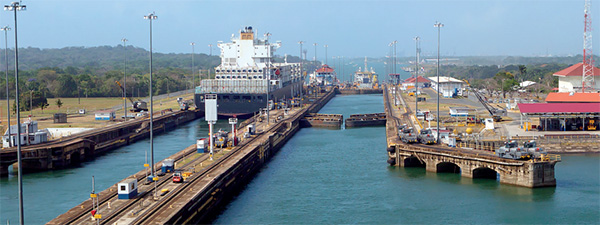Purdue and the Panama Canal
The Lyles School of Civil Engineering’s connection to the Panama Canal goes back for more than a century. From the canal’s original construction to its expansion and continued oversight, Purdue civil engineers have been integral to this modern wonder of the world.
In January 2019, the Purdue University President’s Council ventured out on a cruise through and around the Panama Canal. Attendees were treated to a weeklong trip that included tours throughout the modern wonder and the country itself, as well as a guest lecture by Antonio Bobet, the Edgar B. and Hedwig M. Olson Professor in Civil Engineering and a member of the Panama Canal Geotechnical Advisory Board.

Antoinio Bobet
“It was a great experience,” Bobet says. “Purdue and the Panama Canal have had a long history together and it remains one of the greatest civil engineering achievements of humanity.”
Bobet, who has been on the advisory board since 2012, provided technical expertise for the $5.5 billion expansion that effectively doubled the canal’s size. The project was completed in 2016.
As a board member, Bobet says, his primary role now is to provide the Panama Canal Authority with guidance on issues related to geotechnical engineering — specifically, on matters of stability and preparedness for natural disasters such as landslides and earthquakes.
“From a geotechnical point of view, this is one of the most challenging projects in the world,” Bobet says. “It is exciting to be involved, but also very humbling. It carries a lot of responsibilities.”
There are also a few perks to being a board member, such as serving as guest lecturer on the January cruise. Bobet delivered a pair of lectures during the trip. One lecture was on the Panama Canal itself, and the other was on another of his more notable projects: The Resilient ExtraTerrestrial Habitats (RETH) program.
Established in 2017, the RETH program is a multidisciplinary effort at Purdue that researches how humankind can establish settlements in space. In early 2018, NASA announced that Purdue would be one of the two universities to lead its new Space Technology Research Institute. The institute was created to advance space habitat designs using resilient and autonomous systems.
“Going in, I wasn’t sure if the general audience would be so interested in the Panama Canal or what we are doing with RETH. But everyone seemed to be really engaged and wanted to know more,” Bobet says. “I guess it just goes to show you that no matter what your background is, if you are a Purdue alum, you maintain a high level of interest in a great many things.”
The Purdue President’s Council represents a tradition of support that ensures the University’s continued excellence by helping to create new scholarships; increasing faculty support; funding cutting-edge facilities and innovative programs; and keeping a Purdue education affordable. Visit purdue.edu/pc for more information.

